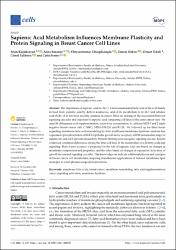| dc.contributor.author | Küçüksayan, Ertan | |
| dc.contributor.author | Sansone, Anna | |
| dc.contributor.author | Chatgilialoglu, Chryssostomos | |
| dc.contributor.author | Özben, Tomris | |
| dc.contributor.author | Tekeli, Demet | |
| dc.contributor.author | Talibova, Günel | |
| dc.contributor.author | Ferreri, Carla | |
| dc.date.accessioned | 2023-10-11T08:06:41Z | |
| dc.date.available | 2023-10-11T08:06:41Z | |
| dc.date.issued | 2022 | en_US |
| dc.identifier.uri | https://www.scopus.com/record/display.uri?eid=2-s2.0-85122674599&origin=resultslist&sort=plf-f&src=s&nlo=&nlr=&nls=&sid=20c4fe371b9b908d4f7e419f791331ff&sot=aff&sdt=cl&cluster=scofreetoread%2c%22all%22%2ct&sl=72&s=AF-ID%28%22Alanya+Alaaddin+Keykubat+University%22+60198720%29+AND+SUBJAREA%28MEDI%29&relpos=87&citeCnt=9&searchTerm= | |
| dc.identifier.uri | https://hdl.handle.net/20.500.12868/2412 | |
| dc.description.abstract | Abstract: The importance of sapienic acid (6c-16:1), a monounsaturated fatty acid of the n-10 family
formed from palmitic acid by delta-6 desaturase, and of its metabolism to 8c-18:1 and sebaleic
acid (5c,8c-18:2) has been recently assessed in cancer. Data are lacking on the association between
signaling cascades and exposure to sapienic acid comparing cell lines of the same cancer type. We
used 50 µM sapienic acid supplementation, a non-toxic concentration, to cultivate MCF-7 and 2 triplenegative breast cancer cells (TNBC), MDA-MB-231 and BT-20. We followed up for three hours
regarding membrane fatty acid remodeling by fatty acid-based membrane lipidome analysis and
expression/phosphorylation of EGFR (epithelial growth factor receptor), mTOR (mammalian target of
rapamycin) and AKT (protein kinase B) by Western blotting as an oncogenic signaling cascade. Results
evidenced consistent differences among the three cell lines in the metabolism of n-10 fatty acids and
signaling. Here, a new scenario is proposed for the role of sapienic acid: one based on changes in
membrane composition and properties, and the other based on changes in expression/activation of
growth factors and signaling cascades. This knowledge can indicate additional players and synergies
in breast cancer cell metabolism, inspiring translational applications of tailored membrane lipid
strategies to assist pharmacological interventions. | en_US |
| dc.language.iso | eng | en_US |
| dc.relation.isversionof | 10.3390/cells11020225 | en_US |
| dc.rights | info:eu-repo/semantics/openAccess | en_US |
| dc.subject | Membrane fatty acids | en_US |
| dc.subject | Breast cancer | en_US |
| dc.subject | Membrane remodeling | en_US |
| dc.subject | Fatty acid supplementation | en_US |
| dc.subject | Cancer signaling activation | en_US |
| dc.subject | Membrane lipidome | en_US |
| dc.title | Sapienic Acid Metabolism Influences Membrane Plasticity and Protein Signaling in Breast Cancer Cell Lines | en_US |
| dc.type | article | en_US |
| dc.contributor.department | ALKÜ, Fakülteler, Tıp Fakültesi, Temel Tıp Bilimleri Bölümü | en_US |
| dc.identifier.volume | 11 | en_US |
| dc.identifier.issue | 2 | en_US |
| dc.relation.journal | Cells | en_US |
| dc.relation.publicationcategory | Makale - Uluslararası Hakemli Dergi - Kurum Öğretim Elemanı | en_US |


















